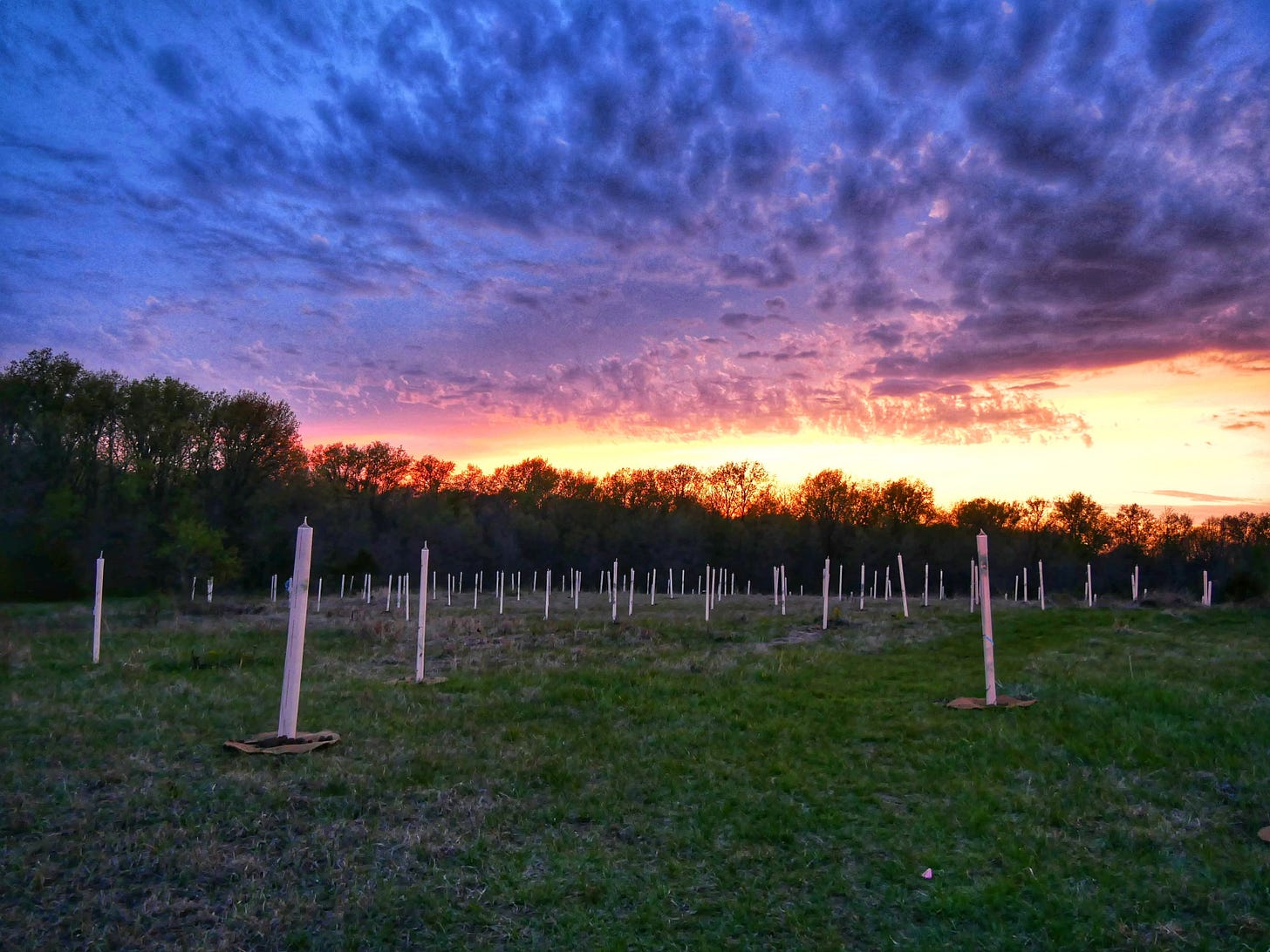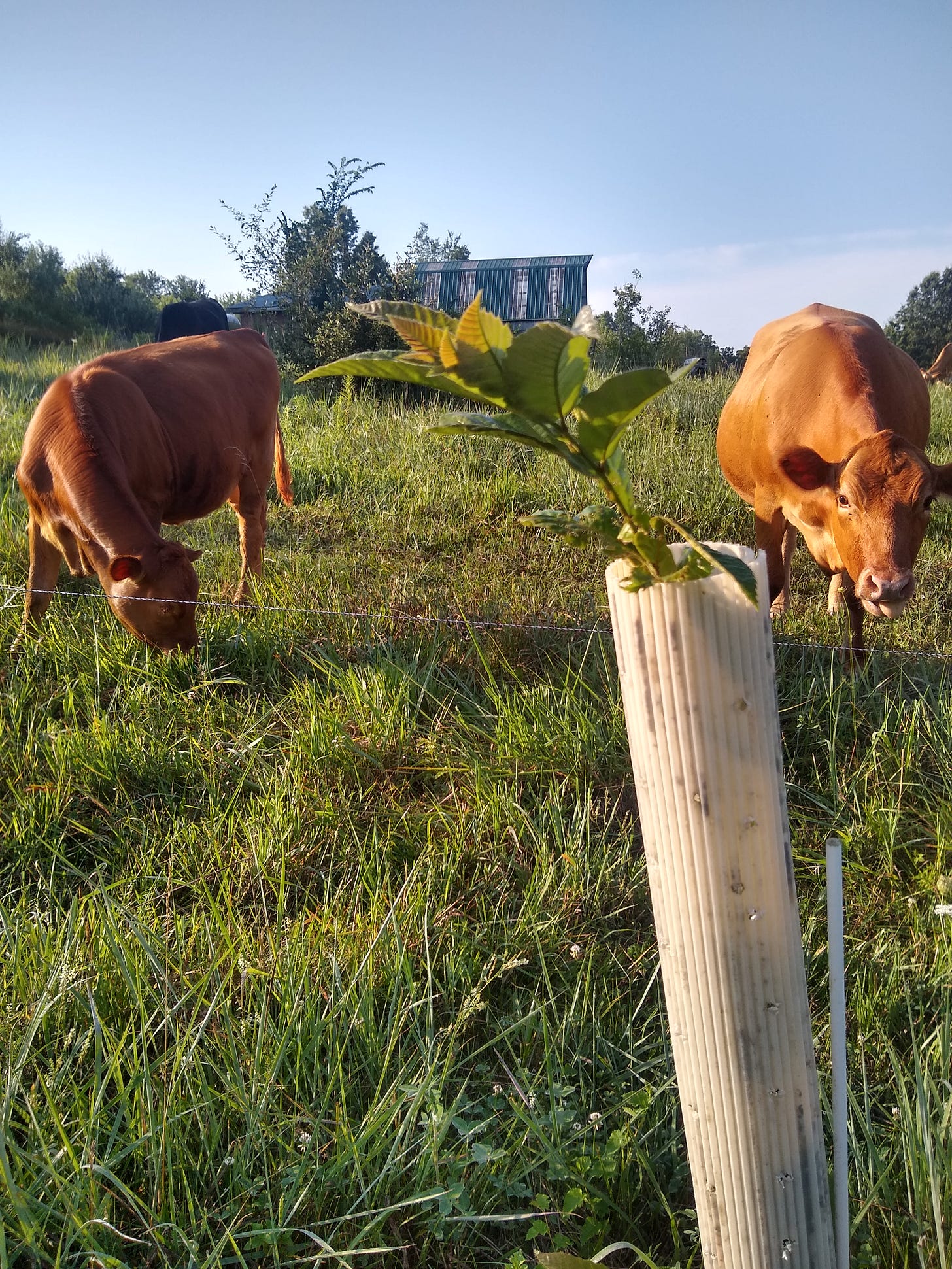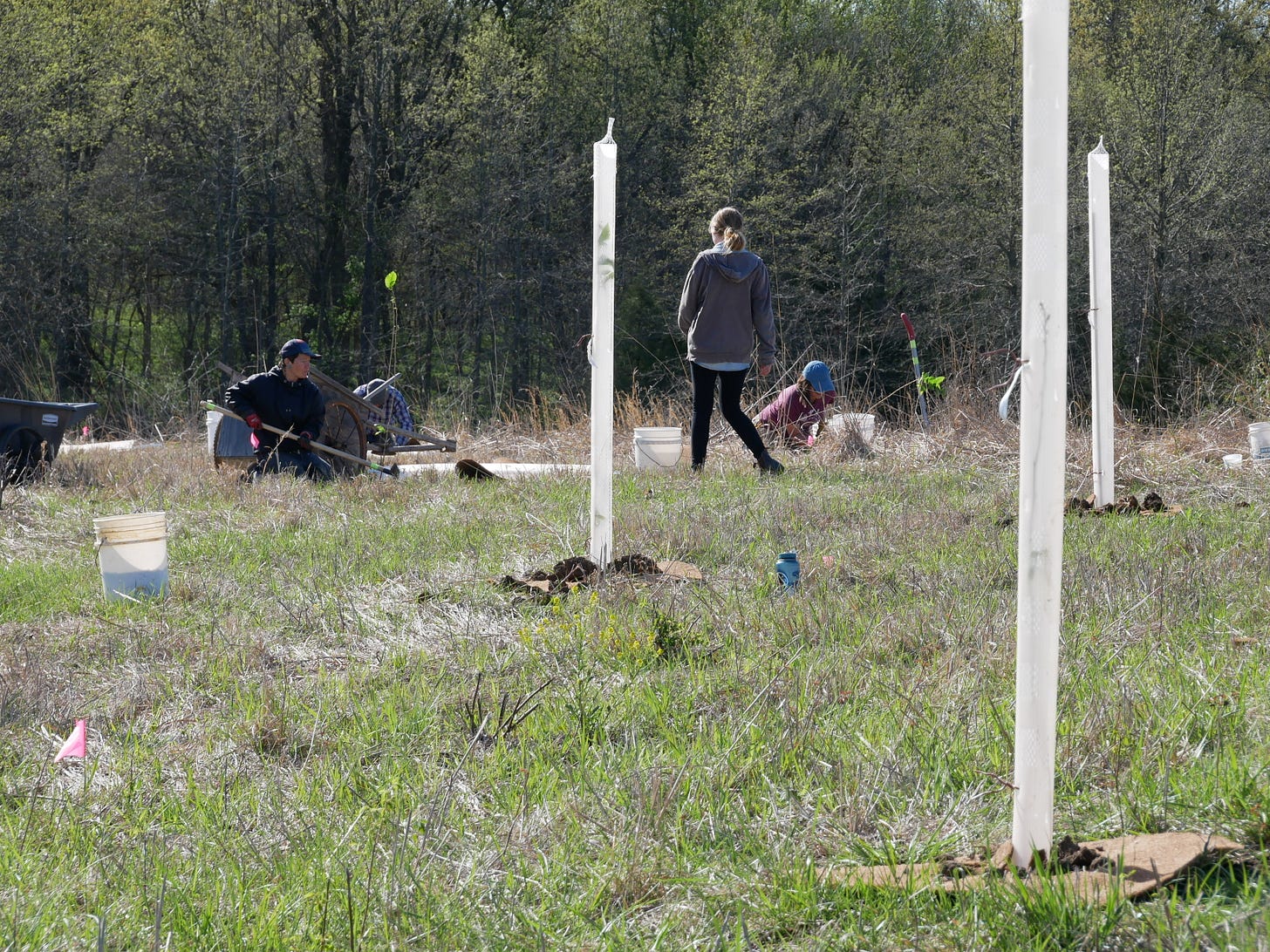The Utopian Solar-Punk Future is Here... and It's Wrapped in Plastic.
On the murky compromises we make in pursuit of a better world

Before the rain we lay the root-mass of vegetative life unfolding, of awakening seedling trees, down in cool chasms in the ground, scoured out by the winding spiral threads of the auger– sod torn from the earth, the soil augmented with sulfur and rock phosphate, upon points flagged and marked and mapped and subjected to social, economic and geospatial calculation. One by one, and with the brisk care of human hands, the tamping of a boot or shovel, a drink of water, and the final coronation of the trunk and stems and above-ground parts of each tree with a 71-inch-tall tubular plastic shelter for protection from deer, rabbits, voles and other browsing, gnawing varmints, we are planting an orchard, of sorts, but I choose to consider it in other terms.
Stitched across undulating slopes of Northeast Missouri glacial till, we have placed column and row after column and row of high-potential chestnut seedlings, ample staple nutrition for generations of human and animal inhabitants to come. It is not only a repository of genomic possibilities, but like each root and root hair soon to slowly make its way through the shovel-scored sides of the augured earth, a stabilizing presence on this land, and we hope, in our wider community.
For two days, the pace of our work remained steady until the two-hundred-fiftieth set of roots was buried and watered and tamped and sheltered and mulched– a long delayed homecoming since the seed was harvested and selected and germinated in a nursery and transported and hardened off and transported again and again. The upfront cost of this project, both economic and material, is considerable, at least to somebody like me who has managed to establish so much on such a shoestring budget. As I’ve alluded to in previous almanac entries, the compromise between establishing this project, a potentially good thing, and the immediate impact of its deployment, a potentially morally murky thing, is not lost on me.
Leading up to this point we have purchased a lot of plastic already. There are the aforementioned tree shelters, bound to fiberglass rods with rubberized twist ties, capped with nylon nets intended to keep perching songbirds from falling to a certain death inside the tubes. Soon, we will be investing in an irrigation system– composed of perhaps miles of plastic tubing, plus all the 5 gallon buckets employed in the transport of water and mined minerals and compost. While I have no doubt that we planted a very big seed here, one that can offer an economic alternative to extractive and degradative agricultural practices in our region, to suggest that a meaningful transition to a viable alternative is an act performed with ethical purity is a statement ungrounded by legitimate consideration, to say the least.

Still, there are few things that feel better than the smug satisfaction of completely preparing a field and planting a crop before a well-timed rain, particularly a field of high-value trees that will bear nutrition and ecosystem services for generations to come– performing this work with a focused collective of inspired and engaged neighbors is one of them. And as much as I would like to not only bask in the feelgood afterglow of this accomplishment, but also take the time to lay out one vision for a radically sustainable food future, I need to also address some practicalities encompassing this work. The utopian solar-punk future of our collective dream may be on the horizon, but for the time being it is still held in a film of cellophane packaging. And while I’ll fess up to being something of a utopian myself, I fear that magical thinking in combination with mismanaged priorities may well prove themselves a greater harm to our collective movement than the tyranny of the corporate class or some conspiracy led by “powers that be”.
The solar-punk future is already here, and it involves unpleasant work. Some of it involves hygienically managing our own fecal matter, or running counter to our instincts and deploying bureaucracy and organization– the chains we forge in life are the ones we wear. Other times, we propel ourselves towards that utopia on the horizon through compromise, or morally ambiguous decision-making. Allow me to offer an example that will no doubt trigger some of y’all. I think you may as well read it anyways.
This morning, amidst a squall of rain and easterly wind, I shot a raccoon through the head. I may or may not eat it, depending on how long it takes me to write this. Last night, this raccoon managed to reach through a compromised plywood corner in a much-used chicken tractor housing a batch of pullets, and pull off three of their legs, leaving a trail of thin, cracked and bloody bones. Despite my tendency towards anarchism, I hold some guidelines for myself in situations where I might cause grievous injury to a varmint. For one, I do my best to not create situations where predation is inevitable in the first place. I employ guard dogs, adequate fencing, and safe housing, as resources allow. I attempt to compost in a way that does not draw varmints near to vulnerable livestock, and we leave large amounts of habitat for wildlife to engage in their natural feeding cycles without the need to stalk the barnyard for prey. At pasturing, I choose to accept small losses– a bird or two here or there– as a taxation for my co-existence with native fauna. But when a varmint is brazen enough to come into our yard to dismember birds two nights in a row, the live-and-let-live fuse is blown, and the offending critter’s fate is predetermined. I can’t say for certain that it’s “right”, but it’s definitely what I do.
In terms of performing a quick and humane dispatch, this helps. If the varmint crosses the rubicon, I needn’t consider very much other than how to end the issue painlessly. I detach myself from judgment, and without pondering doubt or pangs of vengeance, I neutralize the subject. It is not work that I relish, nor deeply detest. I prefer not to do it, but the margins I exist on create little tolerance for repeat offenders. Much of my work I prefer to approach full-hearted, but for varmints, I require unflinching calculation. On account of our current practices, I don’t normally have to do this more than once or twice a year, and only in service of a larger moral motivation– feeding folks in a resource and land efficient manner– I feel obligated to perform it. Like the plastic entombed trees of the field, I make no claims to like it, but understand it as part of the cost in the larger calculus of food system repair. I do reflect on it afterwards, if only to consider what could be adjusted to discourage the event from occurring again. I adjust my practices.
And while I can feel the justifiable disapproval or disappointment of some of y’all, I’d at least like for you to ask yourself if there is any policy in your life, drafted by yourself or some other institution, in which a predetermined rubric of judgment replaces your own morality, or allows for some compromise in values regarding impacts both seen and unseen. Like say, handing over tax revenue for the deployment of weapons, utilizing unfathomable amount of energy to run servers so we can look at memes or watch cat videos, or purchasing a plastic tray of enormous strawberries in the Midwest in winter, gathered and sorted under body-and-mind breaking conditions. I won’t castigate myself, or you dear reader, for eating fresh fruit or popping off the occasional varmint. At least not very much. These are things that require examination, but the work of building a world without them, I’m learning, necessitates strategy in place of sainthood. We can use procedure, policy, and protocol to enact purposeful harm, or to manifest our liberatory visions– I think the work is unpleasant at times either way, so we’re best off making the lines we draw matter.
It’s much more pleasant, and presumable lazy, to imagine a utopian future where folks act on what their heart tells them, without the need of organizational guidance or ethical shortcuts. I even know folks who earnestly try this. Both of the agricultural cooperatives I work within– one for grass-fed dairy, the other for agroforestry– exist in what is currently a largely anarchist format. They function fine at the moment, but I’ve noticed two shortcomings with them.
Employing a non-hierarchical structure can often lead to an “empowerment vacuum”. In order to keep them functioning, one person may inevitably step into a leadership role, even unassumingly, and therefore take on more burden than others. If nobody feels empowered, work doesn’t happen.
Anarchism is predicated upon mutualized survival. Movements towards equity and egalitarianism require everyone has some skin in the game, so to speak. If some members of the collective can weather failure on account of their own privately held resources, while others cannot, their motivation for success will be somewhat disparate. Not necessarily opposite each other, just varied.
And so if our goal was to merely plant 250 trees, we could all feel good about it. We’re off to a great start, in that regard. But the values of this particular project exceed mere establishment. We want to provide a successful, approachable demonstration in a somewhat economically depressed subregion of the Midwest that makes growing food with ecological integrity a viable and convincing choice for our surrounding community. That means organizing distribution, marketing, processing, and economic modeling once the feelgood honeymoon phase of planting a bunch of trees fades. It also means sharing a vision with others, which is harder than some might think.
One compromise that well-meaning collectives often make early on that I would advise against is starting off with a broad coalition of folks– I think that’s something you can grow into later. In order to execute a meaningful project, your core group needs equal alignment in vision and passion. Good luck finding it! With our agroforestry cooperative, we had sufficient energy to establish this planting. After a couple of years, we’ll have better data on what it takes to maintain it. Around the time that it begins yielding significantly, or the end times come, whichever is first, we can swing our doors wide open to folks who only show up for harvesting or processing or marketing or what have you, that is, folks only looking to draw some pay— an understandable and totally fine and expected demographic we expect to serve. Striving towards a worker-owner model, however, necessitates a shared vision, and fairly equitable labor investments at first. I’m not sure if there is any example of a functional utopian model out there, so I’d beware of any community or establishment claiming such. It sounds like a place freeloaders would tend to congregate.
The times are desperate. So we act out of desperation. Sometimes, I fear that a shift to utopianism, as described in the solar-punk fantasies that some of us are actively living out, is a coping mechanism in relation to such desperate times. It’s true that we can act on our ideals, and sometimes make the world a better place, at least locally. But I wonder, at least, if building a better world requires some injury and scarring of our hearts. System change requires tenacity, and when somebody is described as tenacious, or ambitious, what people often mean is that they’re kind of an asshole. And I don’t know of too many visions of utopia that explicitly require one or two assholes to keep things functioning. Nonetheless, a functional vision might. I sure do hope there’s a space at the table for assholes in utopia, for myself at least.
Bad as I am with establishing boundaries with others (and myself) at times, I do see the need in drawing a few lines– between when to harden and when to soften my heart in pursuit of some greater good, for example. I don’t like admitting it, but for the grand project of ecosystem repair, liberation, and the continued survival of life on earth to proceed, we’ve got to get better organized. It may not be your revolution if you can’t dance, but it ain’t my utopia if we can’t work effectively. Apologies for being such a crusty old sour-puss— I have to go cut up a raccoon later.
There are a few partial truisms about the work we agree needs done. One is that by working within the system to change the system, we become the system. In myself, I can see the risk, but I don’t think they’ll have me. But “the system”, for all its cruelty, calculation, and hard-heartedness, is effective. It’s primarily effective at keeping its stakeholders comfortable and destroying the earth, but it also does manage to feed a significant part of our global population (but not enough)— better than a lot of the current alternatives can boast. In the alternative agriculture world, the desire to not “become the system” could likely manifest in mass starvation– and where things get even scarier is when the self-appointed leaders of this movement write off the noble work of feeding people as “unrealistic” within the dogmatic framework of the alternatives they endeavor to sell you. It ain’t my permaculture utopia if people starve. And so, yes, I would like to become the system, if the alternative is global famine.
A consistent and at times heavy rain plummets across block after block of rooting, awakening, unfurling chestnut trees. At times the sky lightens a moment, and the pall of April cloud cover recedes, but these moments are brief, and volleys of heavy droplets are heaved again upon this old worn-down slope of Northeast Missouri glacial till. It looks to be several more days of this, and so long as the precipitation doesn’t cross that line from nourishing to extreme, I’m content for now. I’m proud of the work we’ve done here– blisters and tick bites included. But in my corner of utopia, the roof has two leaks in it, I’m two weeks behind on getting the poultry and swine on pasture, there’s an unrelenting wave of payments and invoices to tackle, and I’ve accumulated a truly heinous laundry pile on the floor– I needn’t detail the status of our humanure system.
There are plans and protocols I can enact to cut through this work, ways of organizing myself, even chains of bureaucracy I can forge and adorn myself and my family unit with, in order to ensure that the greater good, and our collective, continued survival, is materialized, and the laundry is washed and dried. But there’s no guidelines I can recommend for how we keep our hearts properly toned and guarded here in the clatter and chaos of a world careening towards desperation. I s’pose it’s a line we all must draw with intention, and it’s your turn with the pen.





Thanks for this Ben. Would be interested to know how you go about cooking the racoon for a dinner if you end up doing that.